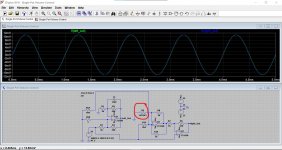Hi,
i've been reading a chapter 22 (p1534) about improving the fader offness and theoretically to reach -120dB. There are several posts here on the forum where even Douglas himself defines "offness".
I find this topic quite interesting, maybe not enough covered either in his book but also here on the forums. Not sure if it's okay to post here a circuit from the book. Please let me know if i have to remove it - i'll do that immediately.
Made it on the breadboard and i can't get lower than -80dB.
Any recommendations, ideas, advices?
Thanks
i've been reading a chapter 22 (p1534) about improving the fader offness and theoretically to reach -120dB. There are several posts here on the forum where even Douglas himself defines "offness".
I find this topic quite interesting, maybe not enough covered either in his book but also here on the forums. Not sure if it's okay to post here a circuit from the book. Please let me know if i have to remove it - i'll do that immediately.
Made it on the breadboard and i can't get lower than -80dB.
Any recommendations, ideas, advices?
Thanks
Attachments
Although not a fan of D.Self he is innovative .
I have never worked on studio consoles or the like but I take it its basically a "signal reducer " ( level reducer ) ?
In that case its down to the quality of the components , I would change the 2.2uf electrolytic for a start to a polypropylene-FILM capacitor-- not metalised but PP-film.
I know DS wouldn't agree with that but that's what I would do.
I have never worked on studio consoles or the like but I take it its basically a "signal reducer " ( level reducer ) ?
In that case its down to the quality of the components , I would change the 2.2uf electrolytic for a start to a polypropylene-FILM capacitor-- not metalised but PP-film.
I know DS wouldn't agree with that but that's what I would do.
It doesn't matter who designed the circuit but rather that the topic is not well covered anywhere (or i can't find the right approach to solve the problem).
Changing the capacitors could improve the Fc but this is not going to reduce to -120dB offness.
What it does, and this works fine, instead of R5 you can dip the small trim pot. Adjusting it, the dB level is really changing from around -50dB to around -80dB but not further than that. The same with R4.
Changing the capacitors could improve the Fc but this is not going to reduce to -120dB offness.
What it does, and this works fine, instead of R5 you can dip the small trim pot. Adjusting it, the dB level is really changing from around -50dB to around -80dB but not further than that. The same with R4.
The 220k:10r MUST be trimmed to exactly match the offness of the pot. Which will vary from brand to brand, batch to batch, day to day.
There are very few real needs for a fully off pot. Not in domestic listening. (If you need silence, lift the needle or pause the player.) (Or add a MUTE switch.) Not really in studio music mix-down. (All live signals in the console should be same key same beat and destined to sit in the same track.) The main exception is radio/TV *network* consoles, where you have Flower Hour in one line and Football Finals in another: leaking the sports racket onto the flower show may offend some listeners.
There are very few real needs for a fully off pot. Not in domestic listening. (If you need silence, lift the needle or pause the player.) (Or add a MUTE switch.) Not really in studio music mix-down. (All live signals in the console should be same key same beat and destined to sit in the same track.) The main exception is radio/TV *network* consoles, where you have Flower Hour in one line and Football Finals in another: leaking the sports racket onto the flower show may offend some listeners.
Maybe you buy a better pot, the Alps RK501 is guaranteed -120dB, but it is big.
Or you use a 100k pot where even small 9 or 16mm have -100dB minimal attenuation.
Also do not measure very small values in the breadboard, but solder the measuring leads directly to the pot.
The circuit is supposed to do good, but when the pot wears out with time and use, the residual resistance might change and the pot would do -90dB, but the compensation will insert a -80dB signal into the negative leg and dominates now.
Or you use a 100k pot where even small 9 or 16mm have -100dB minimal attenuation.
Also do not measure very small values in the breadboard, but solder the measuring leads directly to the pot.
The circuit is supposed to do good, but when the pot wears out with time and use, the residual resistance might change and the pot would do -90dB, but the compensation will insert a -80dB signal into the negative leg and dominates now.
Relying on pot characteristics staying the same is a disaster waiting to happen. It reminds of a circuit I have (from Wireless World and using 3 single opamps) that allows a stereo (two channel) volume control to be made using a single gang pot. One resistor (R9) needs trimming to within 1 ohm and it also relies on the pots wiper having a zero ohm contact with the resistive track. The pot is R5A and R5B
Brilliant idea but flawed.
Brilliant idea but flawed.

